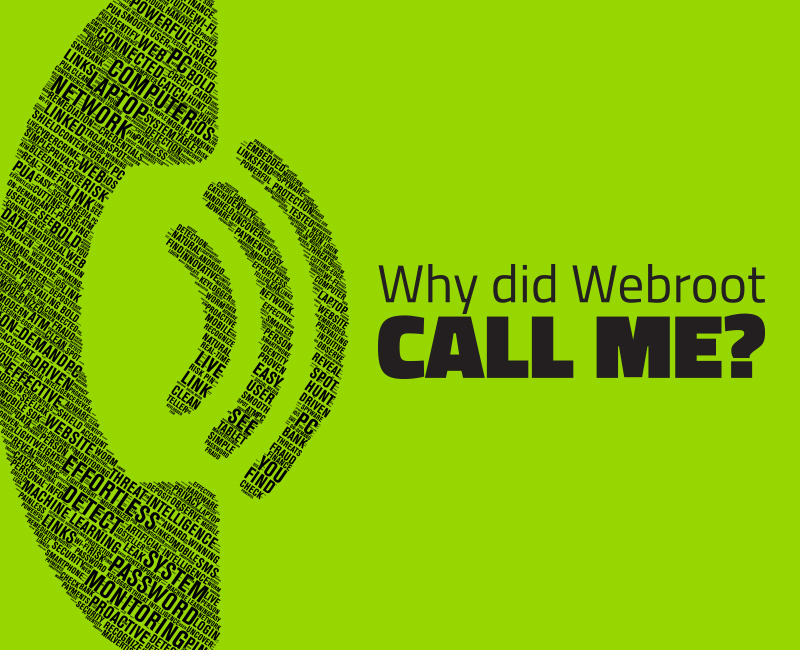Raise your hand if you’ve ever received a call from a company, unsolicited, that got aggressive? Maybe the caller wouldn’t hang up or kept calling back. Maybe the caller asked for money or made a threat. Regardless, you were upset. But when you alerted the company of the bad deed, they gave you some line about phone “spoofing.” Your gut reaction might have been to call BS. But it’s not. Phone spoofing remains a thorn in the side of many consumers across America. According to an online survey conducted by Harris Poll for Truecaller, roughly 27 million Americans reported losing money to phone scams over the last 12 months, a 53 percent increase from 2014.
At Webroot, we’ve heard from our customers they’ve been targets of phone scammers and we want to help educate our community.
We encourage our customers to steer clear from doing business with any callers claiming to be
- tech support and requesting access to your computer to “fix a problem” and charge you;
- Webroot and trying to sell you a lifetime SecureAnywhere subscription
Webroot teammates DO NOT make unsolicited outbound calls to customers. If you have been a victim of such callers purporting to be Webroot, file a complaint with the FCC. The FCC collects data to track down and prosecute scammers. (Anyone who is illegally spoofing can face penalties of up to $10,000 for each violation.)
What is Phone Spoofing?
Phone spoofing is when a scammer makes another person’s or company’s phone number appear on the receiver’s caller ID in an attempt to impersonate that individual or organization. The end goal is to gain access to your personal information and/or get you to pay for a fake service.
How can I protect myself from phone spoofers?
As a consumer, you have rights and options.
- If a number repeatedly calls and doesn’t leave a message, block it.
- If you do pick up and it seems like a bogus call, hang up immediately. However, you may find yourself on the other end of a questionable conversation. In this case, place the caller on hold and call their incoming number. If someone picks up on the other end from the company, ask whether or not the person on hold is calling on their behalf. The key is not to share any personal information.
- Finally, educate your community. Help others in your life understand what phone spoofing is and how to protect themselves. You wouldn’t use a third party to call if you were stuck in Nigeria and needed a loan! Discuss scams you’ve received and how you handled with friends, so they are aware of the scenario and the appropriate actions to take. We’ve also provided resources to help you navigate keeping yourself safe..
How to stop phone spoofing
The government and telecom industry are working together to put a stop to spoofing. The Truth in Caller ID Act, passed in 2009, prohibits any person or entity from transmitting misleading or inaccurate caller ID information with the intent to defraud, cause harm, or wrongly obtain anything of value. Also, the tech and telecom industries are working on solutions. Similar to our antivirus solutions for email and internet safety, there may soon be better anti-spoofing protections for voice.
Americans receive 15.8 spam calls (cell and/or landline) and 6.3 spam text messages in an average month. Until a complete solution is found, remain vigilant about protecting your personal information.








AT&T is unfriendly to those who want to block calls, whether cellphone or landline – in fact, particularly for landline. You can only block 10 numbers (and the spoofing callers change numbers all the time) and they charge you for it. They also won’t allow the use of Nomorobo on their landlines. I’m already on the Do Not Call List and it does nothing to stop these calls from coming through. Contacting the FCC doesn’t work either because they just disappear, then reappear under a new nam
Virginia, go to nomorobo.com. Nomorobo does cover AT&T. Nomorobo is a great service and it is free.
Yes that is exactly what happened to me. The caller ID said Webroot. I told the guy that I was busy and he should call me back in an hour but he never did. Good to get confirmation from Webroot about these calls.
I have been receiving frequent calls on our basic land line from persons with India Indian accents who ask to speak to William. I listen patiently while the person earnestly explains he is from some tech support company and my computer has been sending out messages and he will help fix the problem (total scam).
I explain that I am on the Do Not Call Registry and he says he is calling to help me fix the problem.
When I say this is a scam and I will report him to the FBI he gets abusive and I hang up.
Unfortunately our basic land line service with Century Link does not allow me to block calls but I have reported the number to the National Do Not Call Registry Report Abuse page.
Hi, Gary.
Outside of what you’ve already done, unfortunately, there isn’t much else you can do. It’s a fairly common practice nowadays to not answer any calls where you do not recognize the number.
If it’s legitimate or actually urgent, they’ll either leave a voicemail or call back.
Thanks for sharing your story so that other users can be further educated on this subject. I really appreciate your diligence.
Warm Regards,
Josh P.
Social Media Coordinator
Also be leery of answering “yes” to any question! Even as simple as, “Can you hear me?” The scammer records your yes answer, to later claim you agreed to purchasing services. Hate to be so cynical, but if I don’t recognize a number on caller ID, I always assume it is a scammer when I answer.
Those are very shady tactics indeed. We really appreciate you sharing!
Warm Regards,
Josh P.
Social Media Coordinator
Thank you for this. I will try to fwd it to friends who do not have WR choosing another one instead. To me WR is the one and only one and so far at my ‘young age; of 87 Not much can get past me. Thank you for being there for me.
It’s our pleasure to provide information that will help protect you.
Don’t forget to let them know they can try out Webroot completely free for 2 weeks. Just tell them to go to:
http://www.Webroot.com/Trial
We appreciate your support, Jean, and will continue to protect you when you need it most.
Warm Regards,
Josh P.
Social Media Coordinator
The reason the phone companies do not block calls is that they sell your number. If no one could use it why would they pay the phone company. Try Nomorobo for cell phones and some landlines. Works for me. Unfortunately my Landline supplier doesn’t participate
Verizon too doesn’t allow more then 5 callers to be blocked on cells and landlines. This must be changed but can only be done via congressional law or FCC. Call and write your members of congress and demand that this be done. The Do Not Call List doesn’t help in this case.
A question rather than a comment; Is this post relevant to Webroot users in the UK, including the updates.?
Only if you’re getting solicitation phone calls, Barry.
We are not aware if our UK customers are having the same experience.
Warm Regards,
Josh P.
Social Media Coordinator
UK customers ARE getting unsolicited calls.
These instances should all be documented and properly reported, Mary.
Please click here to learn more.
Best,
Josh P.
Digital Care Coordinator
I got scammed just last weekend by a caller claiming to be from APPLE.COM. Online, he looked genuine on line but persuaded me to part with 2 x $300 to supposedly fix my computer. He persuaded me to purchase iTune vouchers to pay for the service and said he would return $300 by mailed check. He was very convincing and took me to the cleaners!
Adrian, make sure you contact your financial institution to see if they can intervene.
For future reference, all security concerns or questions can be handled by our U.S. Support Team located right here in Broomfield, CO:
Support Number: 1-866-612-4227 M-F 7am−6pm MT
Send a Support Ticket: http://wbrt.io/eyqx
Warm Regards,
Josh P.
Social Media Coordinator
I HAVE ALREADY BEEN SCAMED HE GOT ME FOR $800.00 AND TURNED AROUND AND TRIED TO SCAM ME FOR $750 MORE BUT I WOKE UP AND STOPPED HIM. I THINK HE IS STILL TRYING, BUT I DO NOT ANSWER THE PHONE.
We should also contact our legislative representatives to get them to pass legislation to STOP all these robo dial calls..
There is an app called Call Protect which helps a little for your cell phone. Available at the apple store.
how can i get the fake IRS to stop called my trac phone? i do not know how to block it. i get it once a week saying they will arrest me!!!! thank u. jb
Jennifer, is your track phone an Android? If so, there are apps on the Google Play store that we can suggest in order to do that.
Warm Regards,
Josh P.
Social Media Coordinator
there is no one to complaint to about this. i call the IRS and its automated. cant get a human being to report this to! ty. jb
Yep, I’ve also been called by people telling me my computer has been hacked. He said his name was William. I told him my computer had not been hacked and he got excited and said yes, it had. I said, “William!” when he responded, I told him to get off my phone and hung up.
Even more troubling, I have been called repeatedly by people who claim to be from the IRS and tell me this is my “final warning.” One day I am going to curse at an actual IRS agent and will probably be in big trouble.
In Canada the scammers pretending to be the CRA (Canada Revenue Agency), same as IRS in the states, and took Canadians for millions of dollars. They were from India. The Indian government raided the site, and arrested the individuals. But the comment on the news is they were to late in capturing other call centres in India that were related scammers. And the final nail in the coffin was that it would take 10 to 20 years before it would move through the courts, and the individuals tried. That makes it easier for scammers to continue, knowing that they can evade justice.
How does that work exactly? Would love to pawn them off on that!
I have found the Digitone Call Blocker to be very helpful. It goes between the phone line and your phone.
Thanks for the suggestion, we really appreciate it!
Warm Regards,
Josh P.
Social Media Coordinator